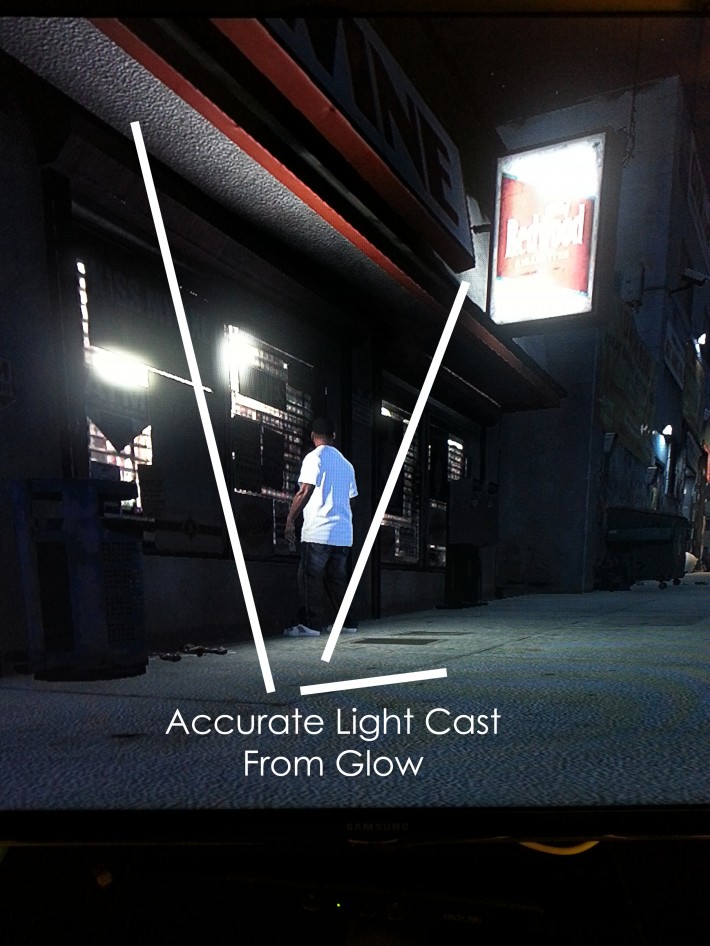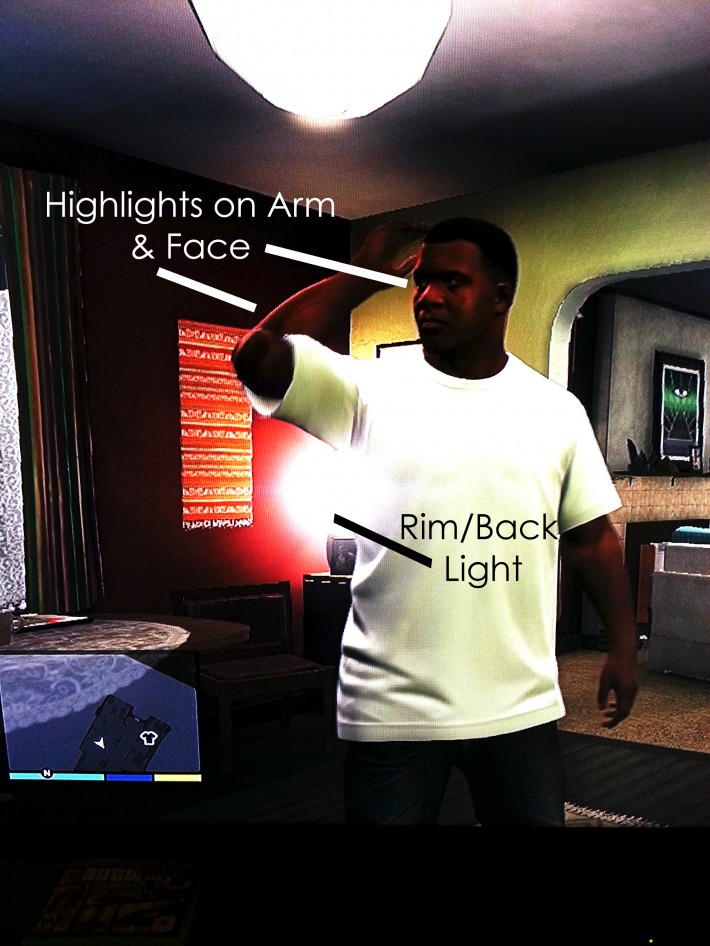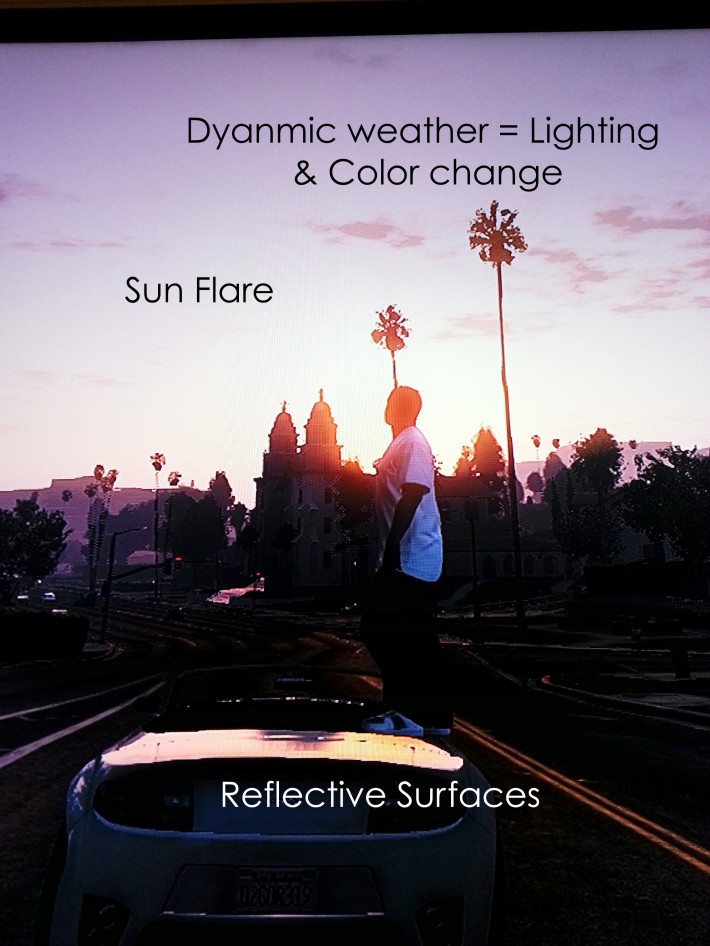Grand Theft Auto 5, which launched yesterday, is the most expensive video game ever produced, at a cost of $250 million of production and marketing costs. It also set records for day one sales. Most of the short time I played over the last day was spent inside the house one of the one of the main protagonists. I moved from room to room and realized I’d just spent almost an hour trying to work out how to position the character for best dramatic lighting effect. As I stepped outside and watched the sunset and saw the lighting change, it got me thinking - can Grand Theft Auto (GTA) 5 actually help us to improve our photography?
Messing around with the lights in GTA 5 is probably not what I imagine most of the millions of people playing the game are trying to do, or what the developers of the game, Rockstar North, probably expected us to be doing. Yet there I was, standing in front of different lights and moving my character about and watching the change.
A lot of the lighting is pretty dynamic, more so than I’ve seen before. As the sun rose, it burst through the blinds and created a wonderful backlight. Outside, the weather and sun patterns change the effect the light has on the character and shadows are directional, hard and dynamic in relation to the sun. Lighting models for man made light sources have been really nicely created and feel very real. I grabbed my phone and snapped a couple of shots direct from the game (please excuse the low quality) to demonstrate how the lighting looks so you can see for yourself.

Shortly before my hour was up, I discovered the character actually has an in-game cell phone is equipped with a camera too, and you can actually bring up a first person view and take shots (as well as share these through the game developer’s social media platform).
This is a very interesting concept for what it means when it comes to practicing photography. Not only does the game look good from our own perspective, as we watch through our TV screen and marvel at how the light changes and affects things like shiny car surfaces or the sides of buildings at sunset, it also means we can actually pull up an in-game camera and see the world through the eyes of the character we happen to be experiencing at any given point in time. It means the next time you happen to be walking about and see a beautiful vista, or a nice portrait opportunity, you can simple take a shot in game for posterity and even share that shot via the Instagram-style in-game app.




It’s no wonder the lighting looks so good. A lot of time, effort and money was spent on getting the landscape and city looking so beautiful. It certainly is one of the key elements that gives the game it’s visual style. The game is set in and around the fictional city of Los Santos, which borrows heavily from the stylization, look and feel of an alternate-reality Southern California, specifically Los Angeles. Aaron Garbut, the Art Director at Rockstar North who developed the GTA series, said:
“Owen Shepherd, our principal lighting artist, has spent the best part of four years working with our graphics coders to create the lighting solution we have in the game. Effectively, he’s been tweaking the values off the back of this throughout that time. There’s a whole world of tech to this but the short version is that we’ve got solution that is far more advanced than I thought we’d ever manage. From the clouds, to the ambient lighting, to the sheer volume of lights we can squeeze on screen, we have something pretty incredible.
I think one of the most amazing features is the way we handle lighting in the game to maintain a consistent look despite the constraints on realistic lighting and shadows on current hardware. Every single light we place in the world is stored, streamed, and laid into the map, even into the distance. The entire world draws all the time: You can fly high in the air at one corner of the map, look over the miles of city and skyscrapers, over the hills and desert to the furthest ridges of the most distant mountains. It’s all there and visible. That’s amazing to see. But the really cool bit is that you can see a street light in a distant town, fly toward it for kilometers until the street itself is visible and the light bulb eventually comes into view. It’s amazing. It’s a level of solidity that I’ve never seen before. It brings the world alive in an incredibly realistic and organic way. That all the lighting the artists have placed to fill out streets and buildings form, at a macro level, the shape of the settlements themselves, that you can look over the desert and see the little towns and trailer parks miles away and get a feel for the road layout even in total darkness and know that it’s not faked, that you can go there: That’s cool.”

As the graphics and lighting within huge expansive games like GTA 5 improves at a relentless pace, and as the freedom to basically move around and do what you want when you want, it opens up possibilities to practice all sorts of photographic techniques.
I’m not sure we’ll see a bunch of people get together for an in-game online photo shoot any time soon, but the concept of seeing more and more realistic lighting effects and how they are dynamically applied (or will be played with by gamers) is certainly an interesting one.
As we move closer to photorealism in games, perhaps there will be a time in the not too distant future where we can begin to model very real lighting scenarios and experiment with them as we would if we had a model in a photo studio.

Do you think you can learn from games, and specifically learn about photographic technique? Would you be interested in a “Best photo from GTA 5” competition? Best Landscape, Best Portrait, Best Auto, Best Commercial, Best Street, Best Sports – the list of categories is pretty extensive. Feel free to post up some shots you capture and let’s have a look at how creative you guys can get.







Enough about the lighting...how do I go about telling my clients that their images are going to be delayed cause I'm staying up til 3 in the morning every night playing GTA5?
Well said!
I'm sure it could... but you might get more out of Crysis 3's lighting engine (see attached photo). Plus Crysis 3 has a sandbox that you can easily create lighting setups. GTA 5 is running on decade+ old technology. There's only so much those geriatric consoles can pull off nowadays. I personally use VRay for my 3D lighting tests, but Crysis 3's sandbox is free :)
Wow, thats incredible...
I forgot to mention that the sandbox is known as CryENGINE 3 and can be downloaded at: http://www.crydev.net/dm_eds/download_detail.php?id=4
Actually Rockstar Games rebuilt their RAGE (Rockstar Advanced Game Engine) engine which is why they were able to do what they on current gen consoles.
wow that's nuts! Eport, what are you using VRay for, CAD stuff or modeling light on people?
Compositing 3D models (as in objects) into my work. 3D modeling and lighting is what got me into photography. I was fascinated by the ridiculous amount of control we have over the emulation of light. For practice though, it wouldn't take much to learn how to use CryENGINE 3 and explore lighting configurations in real time. (Rendering an image for 25-40 min isn't very fun ha!)
The decline of Fstoppers continues unabated...
There's already a guy making use of videogames for photography: http://vee-r.tumblr.com/
Wouldn't the catch lights suggest light source is coming from above down though in title photo?
You need to get a life.
thanks for the positive contribution Larry :)
You could just download blender with the cycles engine and practice any lighting situation you want
This is a nice concept but it has nothing to do with how the game engine actually handles light and shading. Half the things you mention are actually pre-determined lighting maps that have nothing to do with artistic design but with physical simulation of light casting, like material properties. Even worse, some of those examples are just hard-coded and would look the same for changing light!
If you want to learn more about how games handle light, check out this AMAZING lecture by John Carmack, the person who pretty much invented 3D gaming as we know it. - https://www.youtube.com/watch?v=MG4QuTe8aUw
Also, the GTA V engine is not as capable as some of the modern engines running on PC - like Frostbite, CryEngine and Unreal. You should check those out because they offer sandbox modes to play with, and MUCH better lighting simulation:
http://www.unrealengine.com/udk/
http://mycryengine.com/
http://www.frostbite.com/
thanks, that's some cool stuff you've linked there. I just checked out the Cryengine for Cinematics, it's astounding.
Yes it is :) And so flexible too. It's a really great tool if you learn a little about it.
I seriously don't believe what I just read.
WTF was that crap?!?!
It's a slippery downhill slope from here